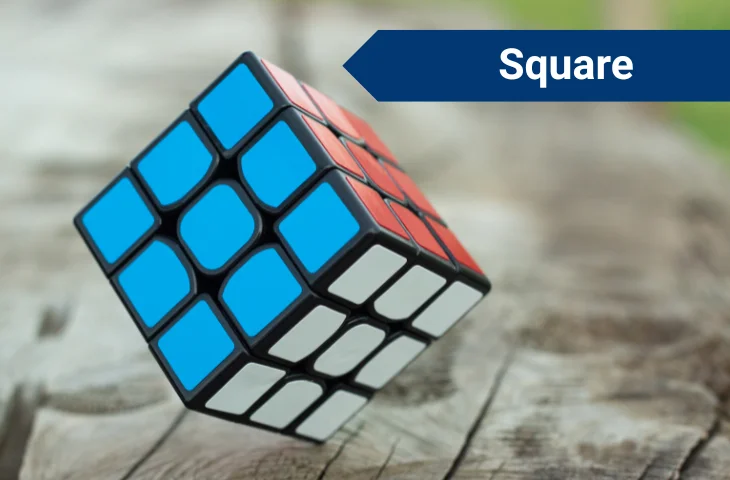The square is one of the simplest yet most frequently tested shapes in Quantitative Aptitude. From perimeter and area to diagonal-based calculations, square questions appear across SSC, Banking, and Railway exams. In this we have provided all the details of square from definitions, formulas, shortcuts, solved questions from recent exams, common mistakes, and smart strategies to solve square-related problems quickly.
What Is Square in Quantitative Aptitude?
A square is a four-sided regular polygon where all sides are equal and all angles are 90°. It is a special case of a rectangle and rhombus.
Why it appears in exams:
Squares are easy to test for geometry basics, mensuration, and number-based applications such as tiling, fencing, and area comparison problems.
Skills required to solve square questions:
- Formula memorization (area, perimeter, diagonal)
- Quick square number calculation
- Ability to relate squares to rectangles and other polygons
Why Is Square Important in Competitive Exams?
Square-based problems are among the fastest scoring topics in quantitative aptitude.
| Exam | No. of Questions | Difficulty |
| SSC CGL / CHSL | 1–2 | Easy |
| IBPS PO / SBI PO | 1 | Easy–Moderate |
| RRB NTPC / Group D | 1 | Easy |
| State PSC / Police | 1–2 | Moderate |
Square Quantitative Aptitude Short Notes
Some of the common terms used to solve questions based on squares are as follows:
| Term | Details |
| Side (a) | Length of one side of the square |
| Perimeter | 4 × a |
| Area | a² |
| Diagonal | a√2 |
| Area from diagonal | (Diagonal²) / 2 |
| Perimeter from diagonal | 2√2 × Diagonal |
| Special property | Square is both a rectangle and a rhombus |
| Application | Fencing, tiling, flooring, land measurement |
Formulas Related to Area and Perimeter of Square
The basic formulas used to solve questions based on the area and perimeter of squares are as follows:
| Concept | Details |
| Area | a² |
| Perimeter | 4 × a |
| Diagonal | a√2 |
| Area using diagonal | (d²) / 2 |
| Number of tiles in square area | Area ÷ area of one tile |
| Square in coordinate geometry | Distance formula to verify equal sides |
What Are the Types of Square Questions in Quantitative Aptitude?
The types of questions asked on the topic of squares are as follows:
- Direct: Area, perimeter, diagonal from side length
- Application-based: Tiling, fencing, cost calculation
- Mixed-concept: Square combined with rectangles, triangles, or circles
- Puzzle-based: Square arrangements and grid problems
Square Formulas for Quantitative Aptitude
Basic formulas related to the topic of squares are as follows:
| Formula | Details |
| Area = a² | Standard area calculation |
| Perimeter = 4a | Total length around square |
| Diagonal = a√2 | Distance between opposite vertices |
| Area from diagonal = (d²)/2 | When diagonal is known |
| Perimeter from diagonal = 2√2 × d | Reverse calculation |
| Number of tiles = (Area of square) / (Area of one tile) | Tiling problems |
Square Tricks for SSC CGL and Other Exams
The short tricks used to solve questions based on the topic of squares are as follows:
- Memorize the first 30 square numbers for quick calculation.
- Use diagonal formula a√2 to avoid double calculation steps.
- For tiling/fencing problems, convert all units to the same measure before solving.
- In cost problems, multiply cost per unit directly with perimeter or area.
- Eliminate unrealistic options using magnitude comparison before full calculation.
Solved Square Questions from 2024–25 Exams
1. SSC CGL 2024 Tier 1 – Shift 3 – Memory-Based
Question: A square field has a side of 50 m. Find its perimeter.
Answer: 200 m
Explanation: Perimeter = 4 × 50 = 200
2. IBPS Clerk Prelims 2024
Question: A square park has an area of 1225 m². Find the length of its diagonal.
Answer: 70√2 m
Explanation: Side = √1225 = 35 → Diagonal = 35√2
3. RRB Group D 2024 – Based on Memory
Question: A square tile of side 20 cm is used to cover a floor of area 8 m². How many tiles are needed?
Answer: 200 tiles
Explanation: Tile area = 0.2² = 0.04 m² → No. of tiles = 8 ÷ 0.04 = 200
Common Mistakes to Avoid while Solving Square Questions
Common mistakes to avoid while solving questions based on the topic of squares are as follows:
- Forgetting to convert units (m ↔ cm).
- Mixing up diagonal and side length formulas.
- Using perimeter formula for area (and vice versa).
- Not squaring correctly for large numbers.
- Skipping diagram for complex application problems.
FAQs
Yes, by verifying equal sides and right angles using distance formula.
Yes, it’s a special type of rhombus with right angles.
Square is a rectangle with all sides equal.
Multiply perimeter or area by rate given.
Divide the diagonal by √2.
- Best Books for IBPS Clerk 2026 Preparation for Prelims & Mains
- OICL AO Salary 2025, Salary Structure, and Job Profile
- OICL AO Cut Off 2025, Previous Year Prelims & Mains Marks
- SSC Stenographer Final Answer Key 2025 Out, Download Response Sheet
- OICL AO Prelims Admit Card 2026 Out, Download Call Letter
- SSC GD Total Form Fill Up 2025-26, Category Wise Details

Hi, I’m Aditi. I work as a Content Writer at Oliveboard, where I have been simplifying exam-related content for the past 4 years. I create clear and easy-to-understand guides for JAIIB, CAIIB, and UGC exams. My work includes breaking down notifications, admit cards, and exam updates, as well as preparing study plans and subject-wise strategies.
My goal is to support working professionals in managing their exam preparation alongside a full-time job and to help them achieve career growth.
